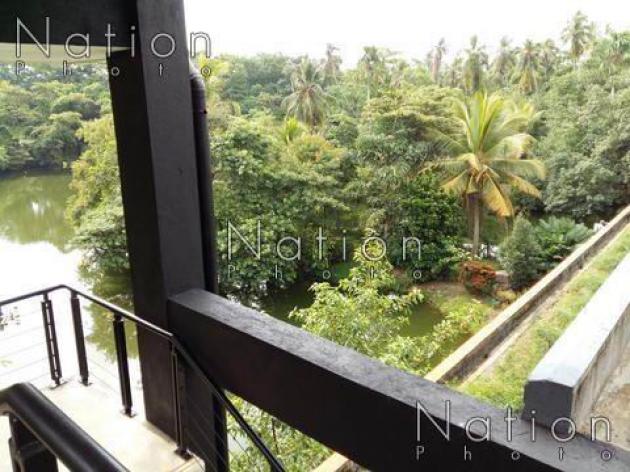Firm strikes balance to make way for nature and humans

Eco-friendly lingerie plant strikes balance to accommodate human activities and nature Trees provide coolness and shade, as innovative systems cut carbon emissions, electricity and water usage, and minimise waste.
Heading towards the premises of MAS Intimates Thurulie is like walking through a public park: big trees almost entirely cover the entrance and perfectly hide the buildings where hundreds of workers are churning out lingerie.
Green shade aside, the plant is adopting innovative systems to reduce electricity and water usage, as well as waste. Such practices have been going on since it commenced operations in 2008 as what is claimed to be the world’s "first eco-friendly factory".
"We want to create something people can come and see, and can understand. At the time, we didn’t know what an eco-plant was. We just wanted to find out what it really meant," said Vidhura Ralapanawe, manager for sustainability and communications and team leader for the building project.
The facility is among several of MAS Holdings, whose operations span a number of countries, such as Bangladesh, China, Mexico and Jordan, employing about 75,000 workers.
Last year, MAS Holdings produced 19 million bras and 8 million pieces of apparel. Some of them – the "green" versions – were manufactured here.
The factory’s claim to be the world’s first eco-manufacturing plant is confirmed by the fact that it was awarded the US Green Building Council’s LEED (Leadership in Energy and Environmental Design) Platinum certificate in 2010, as well as verification from the Green Building Certification Institute.
Its energy and environmental features also won attention from the Holcim Foundation, which promotes construction sustainability.
The idea started when UK-based Marks & Spencer, a major client, announced the eco-initiative in 2006. It planned to set up a green factory in Sri Lanka and contacted three companies, with MAS clinching the deal.
The plant is part of a fabric park spanning 1.65 hectares, and the green idea started with the design stage.
Normally, factories are windowless building blocks for the operation of machinery. However, at this plant – designed and constructed under the human- and earth-centric context – a balance is struck to accommodate both human activities and nature.
Low-rise buildings were built with features that help save energy and water usage.
On the energy side, the buildings are designed to gain the maximum benefit from natural sunlight and lessen dependence on artificial lighting. The ceilings are high and glass walls are used to let in sunlight.
Solar panels also generate power, which accounts for 4 per cent of electricity usage.
As to water usage, rainwater is reserved in small ponds built around the buildings, and water is thoroughly recycled before being released into public channels.
It is estimated that the plant’s tap-water usage is 50 per cent lower than the normal business-usage rate.
Meanwhile, bricks – the main construction material – were sourced from a nearby factory.
Surrounding the buildings are 550 trees, planted to provide natural coolness and shade.
A lean-operations system was adopted to minimise waste and, according to Ralapanawe, children can play with any piece of material around the site. "There’s nothing called waste. We can’t do that anymore," he said.
The buildings cost US$2.66 million (Bt94 million), with Marks & Spencer providing financing to the tune of $400,000, mostly for the green design and the plant’s photo-voltaic system.
The result is that all systems combined help the factory reduce its carbon footprint by 30 per cent compared with conventional forms of production, said the manager.
And this is shown at the electronic board in the reception area, which displays the energy used for the day, total energy used since the plant started operations, and the cut in carbon emissions to date.
Workers, totalling about 1,200 in two shifts, are happy working in the high-ceilinged, air-conditioned buildings, and classical songs are played at the manufacturing site.
For the company’s clients, which include Calvin Klein, GAP, Soma and Old Navy, the carbon footprint of each bra made at the factory is one-third of the footprint of those made at conventional factories.
Ralapanawe acknowledged that this year is the warmest since temperatures were recorded in Sri Lanka in 1980.
"If we don’t embark on something, there will be no business as usual. We can’t wait till the economy catches up," he said.
However, the green path has not been entirely smooth and there have been challenges along the way, he added.
As floor density increased, MAS decided to move low-cost product manufacturing to Bangladesh, and the plant in Sri Lanka focuses only on added value.
Marks & Spencer, the client that inspired the initiative, was forced to shift its focus to cheap items in order to boost margins, he explained. While MAS still produces for the British company, it does so at a plant in Bangladesh.
According to Ralapanawe, despite the challenges, the company’s share
holders agree to maintain the purpose of helping to change the industry, "though this does not significantly improve the bottom line".
More green practices are to be introduced. Despite the density of the trees already planted, another 500 will be grown to achieve greener air around the facility.
Moreover, while all environmental schemes continue, the plant also focuses on education for its employees.
"If we want to stay sustainable, we need to be ahead of others [in our thinking]. We are just used to thinking in functional ways," said the sustainability manager. "Our factory is the place people visit because of something good. They don’t come here because of fires or other [negative reasons]. Our lighting system has been upgraded for the fourth time. At least, those who visit us have something to think about when they go home," he added.





